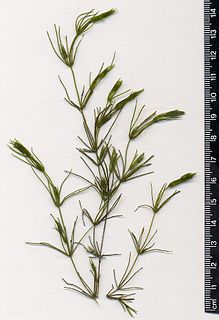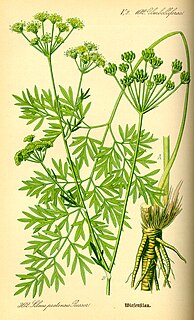
Charales is an order of freshwater green algae in the division Charophyta, class Charophyceae, commonly known as stoneworts. Linnaeus established the genus Chara in 1753.

Saxifraga is the largest genus in the family Saxifragaceae, containing about 440 species of holarctic perennial plants, known as saxifrages or rockfoils. The Latin word saxifraga means literally "stone-breaker", from Latin saxum + frangere. It is usually thought to indicate a medicinal use for treatment of urinary calculi, rather than breaking rocks apart.

Micranthes hieraciifolia is a species of flowering plants. It is native to Europe, North America and temperate Asia, being distributed throughout the high Arctic and some alpine areas like Norway and the Carpathian Mountains, with a few isolated populations in the Central Eastern Alps of Austria and the Massif Central of France. It is generally uncommon.

Saxifraga cernua, the drooping saxifrage, nodding saxifrage or bulblet saxifrage, is a flower common all over the High Arctic. It stretches further south in mountainous areas of the Alps, Norway, Iceland, Siberia and Alaska.

Saxifraga flagellaris, the whiplash saxifrage or flagellate saxifrage, is a plant native all over the high arctic and some areas of northern Rocky Mountains, and Norway. It is not very common. It is also known as spider saxifrage or "spider plant", though the latter name more commonly refers to the unrelated Chlorophytum comosum (Agavaceae).

Saxifraga oppositifolia, the purple saxifrage or purple mountain saxifrage, is a species of plant that is very common in the high Arctic and also some high mountainous areas further south, including northern Britain, the Alps and the Rocky Mountains.

Chrysosplenium is a genus of 57 species of flowering plants in the family Saxifragaceae. Species can be found throughout the arctic and northern temperate parts of the Northern Hemisphere, with the highest species diversity in eastern Asia; two species are found disjunctly in South America.

Saxifraga cespitosa, the tufted alpine saxifrage or tufted saxifrage, is a flower common to many arctic heights. It appears further south in mountainous areas of the Alps, Norway, Scotland, Wales, Iceland, Siberia, western North America and Greenland.

Saxifraga paniculata is an alpine species of flowering plant in the saxifrage family, with native distribution in the temperate northern hemisphere. Common names include alpine saxifrage, encrusted saxifrage, lifelong saxifrage, lime-encrusted saxifrage, livelong saxifrage, white mountain saxifrage, and silver saxifrage.

Micranthes nivalis is a plant species in the saxifrage family. It is commonly called snow saxifrage or (ambiguously) alpine saxifrage.

Chrysosplenium alternifolium is a species of flowering plant in the saxifrage family known as the alternate-leaved golden-saxifrage. It is a mat-forming perennial of wet places that grows between 5 and 15 cm tall. It blooms from March onward.

Micranthes ferruginea is a species of flowering plant known by the common names russethair saxifrage and rusty saxifrage. It is native to western North America from Alaska and northwestern Canada to northern California to Wyoming, where it can be found in moist, rocky habitat in mountainous areas. It is a perennial herb growing from a caudex and rhizome system and producing a basal rosette of leaves. Each leaf is up to 6 centimeters long, thick and fleshy with large teeth along the edges. The inflorescence arises on a slender, hairy peduncle up to 40 centimeters tall. Thin branches bear flowers and reproductive bulbils. Each flower has spade-shaped white petals, the upper ones dotted with gold.
Micranthes howellii is a species of saxifrage known by the common name Howell's saxifrage. It is endemic to the Klamath Mountains of southern Oregon and northern California, where it grows in moist, rocky habitat. It is a perennial herb growing from a caudex, usually with a rhizome system. It produces a basal rosette of leaves with rounded or oval blades edged with dull or sharp teeth or scalloping. Each leaf is up to 6 centimeters long, thick and fleshy, and borne on a short petiole. The inflorescence arises on an erect peduncle up to 20 centimeters tall. An array of branches bear several flowers with small white petals.

Saxifraga rivularis is a species of saxifrage known by several common names, including highland saxifrage, weak saxifrage, alpine brook saxifrage, and pygmy saxifrage.

Micranthes tolmiei is a species of flowering plant known by the common name Tolmie's saxifrage, or Tolmie's alpine saxifrage. It is native to western North America from Alaska to Montana to California, where it grows in rocky mountain habitat types, especially in alpine climates, such as talus and fellfields. It is a small perennial herb growing in mats of creeping stems lined with thick, fleshy leaves each up to 1.5 centimeters long. The inflorescence arises on a stout, erect peduncle with a few stubby bracts midway up. The flowers have narrow white petals and petal-like white stamens.

Saxifraga aspera is a species of saxifrage known by the common name of rough saxifrage. In German it is known as Rauhhaariger Steinbrech. It is placed in section Trachyphyllum of the genus Saxifraga. There are two subspecies, Saxifraga aspera subsp. aspera and Saxifraga aspera subsp. micrantha. It is a plant of the pan-Arctic tundra and is also found in Europe at moderately high altitudes in the Alps, Pyrenees and northern Apennines.

Saxifraga bryoides is a species of saxifrage known by the common name of mossy saxifrage. In German it is known as Moosartiger Steinbrech. It is an inhabitant of the Arctic tundra but it also grows in the Alps and other European mountain ranges at high altitudes.

Silaum silaus, commonly known as pepper-saxifrage, is a perennial plant in the family Apiaceae (Umbelliferae) found across south-eastern, Central and Western Europe, including the British Isles. It grows in damp grasslands on neutral soils.

Micranthes is a genus of flowering plants in the saxifrage family. It was formerly included within the genus Saxifraga until recent DNA evidence showed the members of what is now Micranthes are more closely related to Boykinia and Heuchera than to other members of the genus Saxifraga.


















